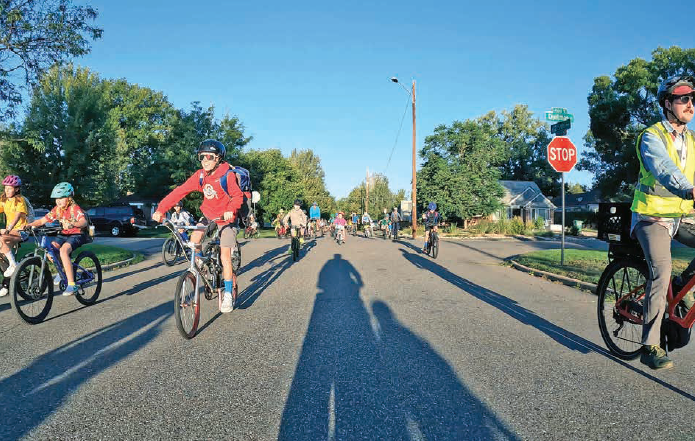As kids start back to school, it’s interesting to think that in 1969 about 48% of kids walked or biked to school, according to the National Center for Safe Routes to Schools (SRTS). Today, that number is closer to 13%.
Approximately 25% of Denver rush-hour traffic today consists of parents driving kids to school. With childhood obesity and ADHD on the rise, one small thing parents can consider is the tremendous benefit of physical activity before school. Physical activity before school has also been shown to improve academic performance for kids.

What has contributed to the decline of kids using active transportation to get to school? SRTS cited that distance to school, danger from traffic, weather and crime were top factors bringing about the change.
To mitigate safety concerns and get kids back into being physically active on the way to school, some parents have shifted to using a safety-in-numbers approach. Two options are the walking school bus and the bike bus.
The walking school bus is a pretty simple concept that has been around for a while. A collection of families who live near each other and are within walking distance to the school form a group. Each morning, a parent from the group will take a turn being the leader of the walking school bus.
That parent will stop at each house, the walking bus stop, along the way to pick up kids. The group then walks together to school. If the kids are older, parents can consider having them meet at a central meeting point and walk to school without an adult.
The bike bus, or “bicibus,” started in Barcelona, Spain, in March 2021. Large convoys of biking children and parents take over the entire street on their route to school. The concept became popularized in the U.S. in Portland when gym teacher and coach Sam Balto started one at Alameda Elementary. Balto used a neighborhood greenway street designed for safe walking and biking to the school.
A group of kids meet up and bike to school together with a few adults helping to lead the group. Some bike buses are massive with 100 or more kids biking. They can be small, with a half-dozen kids and several parents biking with them. There can be routes that merge with each other, or separate groups that meet up at school. Kids can start at the beginning of the route or join the group along its way at designated “bike bus stops.”
Denver’s first bike bus started last May in the Sloans Lake neighborhood. Around 50 kids and parents biked to Brown International Academy on two separate occasions.
For parents thinking about starting a bike bus, picking a route that is safe and convenient is paramount. Bike Streets Denver has a great map of quiet neighborhood streets to consider, and the city of Denver recently updated their bike map to reflect recently constructed bikeways. Pick a route that minimizes crossing busy streets and has small traffic volume. Getting the support of the school administration or Parent Teacher Organization can be helpful in raising awareness for the bike bus and recruiting volunteers to help out.
Parents can ask their school to sign up for Schoolpool, a free service from the Denver Regional Council of Governments (DRCOG). The tool allows parents to connect with others to create groups of kids to get to school together via biking, walking, public transit or carpooling.
Denver’s Community Active Living Coalition offers micro grants for active transportation projects like this. Parents or organizations can apply for financial support to get a bike bus or walking school bus started in their neighborhood. Details can be found at: www.denvercalc.org/microgrants
Allen Cowgill is the City Council District 1 appointee to the DOTI Advisory Board, where he serves as the board secretary, and a volunteer for the Brown International Academy Bike Bus.

Be the first to comment